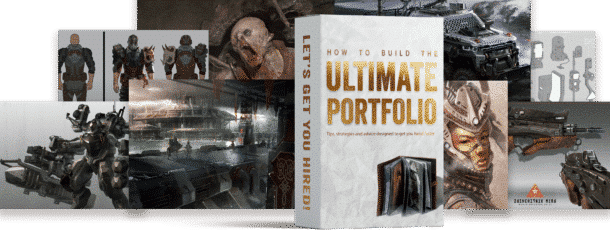SO YOU WANT TO BE A CONCEPT ARTIST WORKING IN ENTERTAINMENT INDUSTRY?
By Eliott Lilly www.eliottlillyart.com
![]()
When you think about it, becoming a professional concept artist is actually quite a simple thing to do, but not easy. It’s something that anyone can do, and yet, most people who start down this path, don’t finish. They will try it for a little bit, dabble and then they give up, and that’s why they don’t get results. It has nothing to do with talent (Ok, maybe a little) but, I firmly believe that in a battle of talent vs. hard work… hard work wins every time. In my opinion, sometimes the difference between “success” and failure is determined by the ambition and determination of the individual.
The good news is that there are only about four major steps that need to be followed to become a professional concept artist. (There are a few others, but they are less major.) If you are ambitious and determined, then you can do this. The Major ones are:
1.Understand what the job really is and what your goals are
There are a few misconceptions about what the role of a concept artist is and what it entails. Do your research and make sure that you want to dedicate yourself to this career path. Going to art school and studying to become an artist is like learning any other trade – It is all that you are being trained to do, so you need to be committed. Sink or swim.
Once you are certain that this you are on the right path, establish a goal for yourself. Say to yourself something like: “I want to become a senior character concept artist working at Blizzard studios on games like Starcraft, or Warcraft.” Let that dream job be the target that you aspire to.
2. Understand what you are good at

Every artist has their favorite thing(s) to draw. If you naturally like drawing characters, then chances are you will want to draw them professionally. Take a moment to evaluate your own strengths and weaknesses (Ask a trusted teacher for advice if you have to). Getting direct feedback will inform you of the areas that you will need to improve.
Keep in mind that even though the industry is booming, it is still relatively small. There are way more artists than jobs available, and as such, competition for these jobs is fierce and the bar is set quite high. If you want to compete, then you will need to get good at drawing the thing(s) that you love to draw. Like REALLY, REALLY GOOD. This means practice.
Spend a minimum of 4 hours a day (outside of class and homework assignments) practicing, learning and training on your own. This is your time to implement what you have learned in school and apply it to your own artistic artwork. Congratulations! You have the beginnings of a portfolio.
3. Build your portfolio around your strengths

Because your portfolio speaks to the client on your behalf, it needs to say: “This is what I am good at doing, and I can deliver this quality of work over and over again.” If all that you have to show at the end of your time in school, is class work- then you do not have a portfolio. You have a bunch of class assignments, which tells the client that you are good at being a student – not a professional.
A good portfolio should play up your strengths and downplay your weaknesses. It should ONLY feature subject matter that you enjoy making, and each image should be of outstanding quality. Take the best of the best images that demonstrate your strengths and arrange them in a coherent manner. Create a website, post your portfolio online, write up your resume (you can get help from https://www.arcresumes.com/ with this) and begin the job hunt.
4. Find a studio that needs your strengths
Know who you are dealing with. If your portfolio demonstrates a certain affinity for highly detailed and super realistic renderings of characters and faces, then sending your ‘folio to companies like Nintendo might be a waste of time. However if you were to submit that same portfolio to Naughty Dog, (makers of Uncharted) they may snatch you up in a heartbeat since you are the right candidate for their needs. Target your portfolio wisely.
And that’s it. If your portfolio is good enough and you apply to the right job. BOOM. You’re in. That’s all it really takes to become a professional concept artist. That said, here are a few more suggestions…
5. Find a mentor and get better
Finding a mentor on the job is like receiving GOLD every day! Ideally, you should be looking for someone who has way more experience and success than you and who is willing to guide you along. However, since that is not always the case spending time learning from a book, instructional DVD, or tutorial will work as well. The point is to learn, improve and grow as an artist.
6. Upgrade to a better studio and better wage.
There comes a time when you outgrow a studio and will have to move on. There always is. It can be due to several reasons, but usually because the project ships (or has changed) and you have no interest in the next one, you’re no longer challenged and excited as you once used to be or all of your peers have left and you find that there is no one left to mentor you. Time to level up.
Hopefully by this point in your career, you will have a few years of experience under your belt along with a shipped title or two. If you were smart, you’ve been constantly improving and working on personal pieces. Now, despite the status of your current full time project, your portfolio looks amazing and you have new job prospects lined up.
Repeat step 4-6 until desired goal is achieved.
Remember that goal you set: “I want to become a senior character concept artist working at Blizzard studios on Starcraft, or Warcraft”… are you there yet? No? Then keep going.
Be sure that the next studio you work at or client you take on, allows you to develop the kind of work in your portfolio that your dream job will find attractive. Each job should bring you one step closer to your end goals. (Keep in mind, however, that you can update your goals over time as you grow).
For a more in-depth look at these steps and more, be sure to check out The Big Bad World Of Concept Art For Video Games: An Insiders Guide for Students“. It covers in great detail what the job of a concept artist really entails, how to choose the right education, what you should be studying and practicing in school, how to properly build your portfolio to land the job you want, and much, much more.


